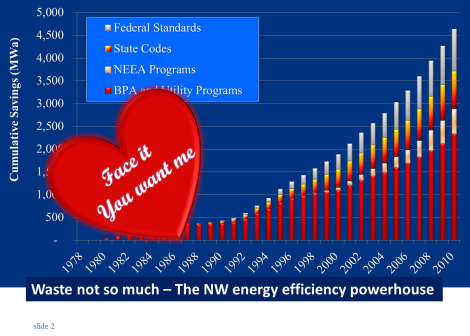 Something must be done about the abysmal marketing of energy efficiency. Never has such a big energy story received so little love.
Something must be done about the abysmal marketing of energy efficiency. Never has such a big energy story received so little love.
In the pie-throwing contest that passes for energy dialogue in our political culture, Solyndra gets the ink, while the biggest story by far goes unreported. Keystone dominates the headlines, while new fuel economy standards languish in obscurity — even though they’ll save far more oil than Keystone will deliver and create more jobs, at a fraction of the cost. Clean energy naysayers offer a rhetorical choice between a “Keystone economy vs. a Solyndra economy“, when the actual economy is running more and more on the energy we save through better codes, standards, and efficiency programs.
Here in the Northwest, for example, we have saved over 4600 average megawatts of electricity since 1980. That’s more than enough to continuously power 4 cities the size of Seattle – and the Northwest only has one city the size of Seattle! If we let the east side of the region have all the good stuff, these energy savings could power the entire states of Idaho and Montana. But we would never do that, of course, because that would make Seattle and Portland dramatically poorer; that conserved energy, harvested from the whole region, is a gold mine, saving consumers about $2.5 billion-with-a-b annually on our power bills.

This is by far the biggest energy story in the Northwest over the last 30 years. The saved energy has met more than half of the growth in demand, at a fraction of the cost of the power we would have otherwise bought. It has extended the value of our regional hydropower system, squeezing more work – more cold beer, more hot showers, more data crunching – out of every drop of water in the system.
But there’s plenty more squeezing to do. The Northwest Power and Conservation Council’s Sixth Plan lays out a cost effective strategy for meeting the vast majority of new energy needs with efficiency over the next 20 years. Oregon’s new draft 10 year energy strategy aims to go all the way – meeting all load growth by wasting less of the energy we’ve got.
And even that’s not the limit. We’ve got coal plants to replace too, and huge power plants of wasted energy – squandered Grand Coulees, Dalles that dribble away – in our existing building stock. Thousands of megawatts of available, cheap energy savings. Thousands of jobs for the people who harvest them… A robust, irresistible, smoking hot energy future, powered by renewables and juiced by efficiency.


